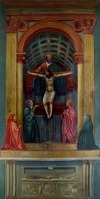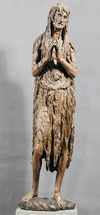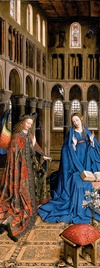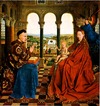The Early Renaissance Flashcards
Classical Antiquity
A broad term for a long period of cultural history centred on the Mediterranean Sea, comprising the interlocking civilisations of ancient Greece and ancient Rome.
Renassance
A cultural movement that spanned the period roughly from the 14th to the 15th century, beginning in Italy in the Late Middle Ages and later spreading to the rest of Europe.
Humanism
Man is the measure of all things
“New Athens”
Humanists in Florence styled their city a “new Athens.” early 1400’s
Medici Family
The Medici family was one of the wealthiest in Europe, and the Medici bank was the most respected financial institution of the time. The family also acquired great political power(Florence), allowing for an environment where art and humanism could flourish. They fostered and inspired the birth of the Italian Renaissance along with other families of Italy

Brunelleschi Sacrifice of Isaac

GhibertI Sacrifice of Isaac
Exterior of the Florence Cathedral started
Dome was added by Brunellechi in 1420-36.

Plan of Florence Cathedral
Linear Perspective
An approximate representation, on a flat surface (such as paper), of an image as it is seen by the eye. (drawing with 1-3 vanishing points.)
Orthogonals
The converging lines that meet at the vanishing point in the system of linear perspective.
Vanishing Point
Is one of possibly several points in a 2D image where lines that are parallel in the 3D source converge.
Horizon Line
It is always at one’s eye level - its placement determines where we seem to be looking from.

Ghiberti- Gates of Paradise, east door, Florence Baptistery 1424-1452

Ghiberti- Story of Jacob and Esau, 1435

Ghiberti- Self-portrait, east door Florence Baptist

Masaccio- Holy Trinity *Correctly portay linear perspective.

fresco
Technique of painting on a moist, plaster surface with colors ground up in water or a limewater mixture.
chiaroscuro
subtle gradation

Masaccio- left side Brancacci Chapel

Masaccio- Expulsion from Eden, Left pilaster of the Brancacci Chapel

Masaccio- Saint Peter
(detail of the Tribute Money)
Aerial or Atmospheric Perspective
The effect the atmosphere has on the appearance of an object as it is viewed from a distance.
Continuous Narration
A way to tell an entire story within one artwork, the same characters show up repeatedly in order to give a timeline of events in the story.

Perugino- The Delivery of the Keys, Sistine Chapel.

Donatello- Saint Mark, Realistic.

Donatello- Saint George Tabernacle

Donatello- David. Scene After battle.
Contrapposto
An Italian term that means counterpose. It is used in the visual arts to describe a human figure standing with most of its weight on one foot so that its shoulders and arms twist off-axis from the hips and legs.
Nude VS Naked
Renaissance
Nude: appropriate.
Naked: shameful.

Donatello- Mary Magdalene

Michelozzo- Palazzo Medici-Riccardi. Larger conrice, rusticated 1st floor, Florence, 1444.
Palazzo
A large splendid residence or public building, such as a palace or museum.
Rusticated
Fashion (masonry) in large blocks with sunk joints and a roughened surface: “the stable block was built of rusticated stone”.
Cornice
The molded and projecting horizontal member that crowns an architectural composition.

Alberti- Rucellai Palace. Florence, 1446-1450.

























